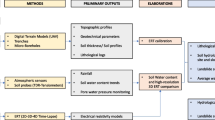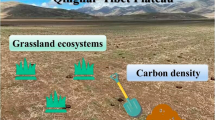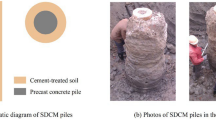Abstract
Eolian loess in China contains abundant information about paleoclimate evolution, but there have been few studies of the relationship between the changing permeability of loess and the paleoenvironment. To investigate how loess–paleosol permeability responds to climate change, 342 undisturbed soil samples were collected from the Jingyang Loess Plateau in the Guanzhong Basin. Permeability was measured by a TST-55 permeameter and soil microstructures were observed with a scanning electron microscope (SEM). The results showed that: (1) the permeability of the loess layers was higher than that of the paleosol layers; (2) loess–paleosol sequence permeability had a four-stage accumulation history; (3) the degree of permeability anisotropy (DPA) of most of the loess was greater than 1, whereas that of the paleosol layers were less than 1; (4) loess and paleosol microstructures were consistent with the results obtained by permeability, whose changes had been mainly caused by the pedogenesis controlled by the Quaternary climate. The higher permeability of the loess layers was largely the result of lower pedogenesis intensity due to the cold/dry climatic conditions at the time when the sediments were deposited. Conversely, the lower permeability of the paleosol layers was the result of higher pedogenesis intensity under warm/wet climatic conditions. Based on the permeability, DPA, and soil microstructures, we concluded that the gradual uplift of the Qinling Mountains and the changes in the intensity of the East Asian monsoon had played important roles in controlling the evolution of the climate in the Guanzhong Basin. Therefore, loess permeability can reflect Quaternary climate change and provide a new research method for interpreting the characteristics of the Jingyang Loess Plateau.














Similar content being viewed by others
Availability of data and materials
The processed data required to reproduce these findings cannot be shared at this time as the data also forms part of an ongoing study.
References
Al-Mukhtar M, Khattab S, Alcover JF (2012) Microstructure and geotechnical properties of lime-treated expansive clayey soil. Eng Geol 139–140:17–27
An Z, Wu G, Li J, Sun Y, Lu Y, Zhou W, Cai Y, Duan A, Li L, Mao J, Cheng H, Shi Z, Tan L, Yan H, Ao H, Chang H, Feng J (2015) Global monsoon dynamics and climate change. J Earth Environ 43:29–77
Cai Y, Tan L, Cheng H, An Z, Edwards RL, Kelly MJ, Kong X, Wang X (2010) The variation of summer monsoon precipitation in central China since the last deglaciation. Earth Planet Sc Lett 291:21–31
Cao M, Jin Y, Liu N, Ji W (2012) Effects of the Qinghai-Tibetan Plateau uplift and environmentalchanges on phylogeographic structure of the Daurian Partridge (Perdix dauuricae) in China. Mol Phylogenet Evol 65(3):823–830
Che X, Li G (2017) Binary sources of loess on the Chinese Loess Plateau revealed by U-Pb ages of zircon. Quaternary Res 80:545–551
Chen Z, Li G (2013) Evolving sources of eolian detritus on the Chinese Loess Plateau since early Miocene: tectonic and climatic controls. Earth Planet Sc Lett 371–372(2013):220–225
Chen T, Xie Q, Xu H, Chen J, Ji J, Lu H, Balsam W (2010) Characteristics and formation mechanism of pedogenic hematite in Quaternary Chinese loess and paleosols. CATENA 81:217–225
Chen Y, Huo WX, Qian H, Li BC (2020) Research on holocene loess erosion associated to climate evolution in china. Polish J Environ Stud 1:409–417
Chen Y, Qian H, Hou K, Zhang Q, Zhang Y (2020) Vertical distribution characteristics of soil moisture with different strata in deep profile in Guanzhong Basin. China Environ Earth Sci 79:103
Clift P, Wan S, Blusztajn J (2014) Reconstructing chemical weathering, physical erosion and monsoon intensity since 25Ma in the northern South China Sea: a review of competing proxies. Earth-Sci Rev 130:86–102
Ding ZL, Yu ZW, Liu DS (1991) Progress in loess research (part 3): time scale. Quaternary Sci 4:336–348 ((in Chinese))
Ding Z, Derbyshire E, Yang L, Yu Z, Xiong S, Liu T (2002) Stacked 2.6-Ma grain size record from the Chinese loess based on five profiles and correlation with the deep-sea δ18O record. Paleoceanography 17(3). https://doi.org/10.1029/2001PA000725
Fang Q, Hong H, Zhao L, Furnes H, Lu H, Han W, Liu Y, Jia Z, Wang C, Yin K, Algeo TJ (2017) Tectonic uplift-influenced monsoonal changes promoted hominin occupation of the Luonan Basin: Insights from a loess-paleosol sequence, eastern Qinling Mountains, central China. Quaternary Sci Rev 169:312–329
Gao L, Shao M, Wang Y (2012) Spatial scaling of saturated hydraulic conductivity of soils in a small watershed on the Loess Plateau. China J Soil Sediment 12(6):863–875
Gao Y, Qian H, Li X, Chen J, Jia H (2018) Effects of lime treatment on the hydraulicconductivity and microstructure of loess. Environ Earth Sci 77:529
Geiss C, Egli R, Zanner C (2008) Direct estimates of pedogenic magnetite as a tool to reconstruct past climates from buried soils. J Geophys Res. https://doi.org/10.1029/2008JB005669
Gu C, Mu X, Gao P, Zhao G, Sun G, Sun W, Tatarko J, Tan X (2018) Influence of vegetation restoration on soil physical properties in the loess plateau. China J Soil Sediment 19(2):716–728
Guo Z, Ruddiman W, Hao Q, Wu H, Qiao Y, Zhu R, Peng S, Wei J, Yuan B, Liu T (2002) Onset of Asian desertification by 22 Myr ago inferred from loess deposits in China. Nature 416:159–163
Guo L, Xiong S, Yang P, Ye W, Jin G, Wu W, Zhao H (2017) Holocene environmental changes in the horqin desert revealed by osl dating and δ13C analyses of paleosols. Quatern Int 469:11–19. https://doi.org/10.1016/j.quaint.2017.06.048
Hao Q, Guo Z (2005) Spatial variations of magnetic susceptibility of Chinese loess for the last 600 kyr: implications for monsoon evolution. J Geophys Res. https://doi.org/10.1029/2005JB003765
Hong H, Li Z, Xue H, Zhu Y, Zhang K, Xiang S (2007) Oligocene clay mineralogy of the Linxia Basin: evidence of Paleoclimatic evolution subsequent to the initial-stage uplift of the Tibetan Plateau. Clay Clay Miner 55:491–503
Hu X, Wei J, Xu L, Zhang G, Zhang W (2009) Magnetic susceptibility of the Quaternary Red Clay in subtropical China and its paleoenvironmental implications. Palaeogeogr Palaeocl 279:216–232
Jiang X, Wang X, Wan L (2010) Semi-empirical equations for the systematic decrease in permeabilitywith depth in porous and fractured media. Hydrogeol J 18(4):839–850
Jiang H, Guo G, Cai X, Thompson J, Xu H, Zhong N (2016) Geochemical evidence of windblown origin of the Late Cenozoic lacustrine sediments in Beijing and implications for weathering and climate change. Palaeogeogr Palaeocl 446:32–43
Klaver J, Desbois G, Littke R, Urai J (2015) BIB-SEM characterization of pore space morphology and distribution in postmature to overmature samples from the Haynesville and Bossier Shales. Mar Petrol Geol 59:451–466
Kukla G, An Z (1989) Loess stratigraphy in Central China. Palaeogeogr Palaeocl 72:203–225
Li X, Li L (2017) Quantification of the pore structures of Malan loess and the effects on loess permeability and environmental significance, Shaanxi Province, China: an experimental study. Environ Earth Sci. https://doi.org/10.1007/s12665-0176855-7
Licht A, Van-Cappelle M, Abels HA, Ladant JB, Trabucho-Alexandre J, France-Lanord C, Donnadieu Y, Vandenberghe J, Rigaudier T, Lecuyer C, Terry D, Jr-Adriaens R, Boura A, Guo Z, Soe AN, Quade J, Dupont-Nivet G, Jaeger JJ (2014) Asian monsoons in a late Eocene greenhouse world. Nature 513:501–506
Liu Q, Deng C, Yu Y, Torrent J, Jackson MJ, Banerjee SK, Zhu R (2005) Temperature dependence of magnetic susceptibility in an argon environment: implications for pedogenesis of Chinese loess/palaeosols. Geophys J Int 161:102–112
Liu W, Huang Y, An Z, Clemens SC, Li L, Prell WL, Ning Y (2005) Summer monsoon intensity controls C4/C3 plant abundance during the last 35 ka in the Chinese Loess Plateau: carbon isotope evidence from bulk organic matter and individual leaf waxes. Palaeogeogr Palaeocl 220:243–254
Lu H, Zhang H, Wang S, Cosgrove R, Sun X, Zhao J, Sun D, Zhao C, Shen C, Wei M (2017) Multiphase timing of hominin occupations and the paleoenvironment in Luonan Basin, Central China. Quaternary Res 76:142–147
Marković S, Hambach U, Stevens T, Jovanović M, O’Hara-Dhand K, Basarin B, Lu H, Smalley I, Buggle B, Zech M, Svirčev Z, Sümegi P, Milojković N, Zöller L (2014) Loess in the Vojvodina region (Northern Serbia): an essential link between European and Asian Pleistocene environments. Neth J Geosci 91:173–188
Muhs D, Bettis E, Aleinikoff J, McGeehin J, Beann J, Skipp G, Marshall B, Roberts H, Johnson W, Benton R (2008) Origin and paleoclimatic significance of late Quaternary loess in Nebraska: evidence from stratigraphy, chronology, sedimentology, and geochemistry. Geol Soc Am Bull 120:1378–1407
MWRPRC, the Ministry of Water Resources of the People’s Republic of China (1999) Standard for soil test method (GB/T 50123–1999). China Planning Press, Beijing (in Chinese)
Pires L, Cooper M, Cássaro F, Reichardt K, Bacchi O, Dias N (2008) Micromorphological analysis to characterize structure modifications of soil samples submitted to wetting and drying cycles. CATENA 72:297–304
Porter S (2001) Chinese loess record of monsoon climate during the last glacial-interglacial cycle. Earth-Sci Rev 54:115–128
Pullen A, Kapp P, McCallister A, Chang H, Gehrels G, Garzione C, Heermance R, Ding L (2011) Qaidam Basin and northern Tibetan Plateau as dust sources for the Chinese Loess Plateau and paleoclimatic implications. Geology 39:1031–1034
Qiao J, Zhu Y, Jia X, Huang L, Shao M (2018) Spatial variation and simulation of the bulk density in a deep profile (0–204 m) on the Loess Plateau, China. CATENA 164:88–95
Rasa K, Horn R, Raty M, Yli-Halla M, Pietola L (2009) Shrinkage properties of differently managed clay soils in Finland. Soil Use Manag 25(2):175–182
Romero E, Simms P (2008) Microstructure investigation inunsaturated soils: a review with special attention to contributionof mercury intrusion porosimetry and environmental scanningelectron microscopy. Geotech Geol Eng 26(6):705–727
Sadeghi S, Singh V, Kiani-Harchegani M, Asadi H (2018) Analysis of sediment rating loops and particle size distributions to characterize sediment source at mid-sized plot scale. CATENA 167:221–227
Stevens T, Marković S, Zech M, Hambach U, Sümegi P (2011) Dust deposition and climate in the Carpathian Basin over an independently dated last glacial-interglacial cycle. Quaternary Sci Rev 30:662–681
Sun J (2002) Provenance of loess material and formation of loess deposits on the Chinese Loess Plateau. Earth Planet Sc Lett 203:845–859
Sun J, Lü T, Zhang Z, Wang X, Liu W (2012) Stepwise expansions of C4 biomass and enhanced seasonal precipitation and regional aridity during the Quaternary on the southern Chinese Loess Plateau. Quaternary Sci Rev 34:57–65
Sun Y, Kutzbach J, An Z, Clemens S, Liu Z, Liu W, Liu X, Shi Z, Zheng W, Liang L, Yan Y, Li Y (2015) Astronomical and glacial forcing of East Asian summer monsoon variability. Quaternary Sci Rev 115:132–142
Sun J, Ding Z, Xia X, Xia X, Sun M, Brian F (2018) Detrital zircon evidence for the ternary sources of the Chinese Loess Platea. J Asian Earth Sci 155(15):21–34
Thomas D, Wiggs G (2008) Aeolian system responses to global change: challenges of scale, process and temporal integration. Earth Surf Proc Land 33:1396–1418
Vandenberghe J (2013) Grain size of fine-grained windblown sediment: a powerful proxy for process identification. Earth-Sci Rev 121:18–30
Vriend M, Prins M, Buylaert J, Vandenberghe J, Lu H (2011) Contrasting dust supply patterns across the north-western Chinese Loess Plateau during the last glacial-interglacial cycle. Quatern Int 240:167–180
Wang J, Xiang W, Zuo X (2010) Situation and prevention of loess water erosion problem along the west-to-east gas pipeline in China. J Earth Sci-China 21(6):968–973
Wang Z, Zhang P, Carmala N, Richard O, Zhang G, Zheng D, Brian H, Yuan D, Li C, Liu J, Wu Q (2012) Magnetostratigraphy and depositional history of the Miocene Wushan basin on the NE Tibetan plateau, China: implications for middle Miocene tectonics of the West Qinling fault zone. J Asian Earth Sci 44:189–202
Wang W, Wang Y, Sun Q, Zhang M, Qiang Y, Liu M (2017) Spatial variation of saturated hydraulic conductivity of a loess slope in the South Jingyang Plateau. China Eng Geol 236(2018):70–78
Wang W, Wang Y, Sun Q, Zhang M, Qiang Y, Liu M (2018) Spatial variation of saturated hydraulic conductivity of a loess slope in the South Jingyang Plateau, China. Eng Geol 236:70–78. https://doi.org/10.1016/j.enggeo.2017.08.002
Wang J, Li P, Ma Y, Vanapalli SK (2019) Evolution of pore-size distribution of intact loess and remolded loess due to consolidation. J Soils Sediments 19(3):1226–1238
Wen B, Yan Y (2014) Influence of structure on shear characteristicsof the unsaturated loess in Lanzhou. China Eng Geol 168:46–58
Xiao G, Zong K, Li G, Hu Z, Dupont-Nivet G, Peng S, Zhang K (2012) Spatial and glacial-interglacial variations in provenance of the Chinese Loess Plateau. Geophys Res Lett. https://doi.org/10.1029/2012GL053304
Yang Z, Qiao J, Uchimura T, Wang L, Lei X, Huang D (2017) Unsaturated hydro-mechanical behaviour of rainfall-induced mass remobilization in post-earthquake landslides. Eng Geol 222:102–110
Zhang P (2013) A review on active tectonics and deep crustal processes of the Western Sichuan region, eastern margin of Tibetan Plateau. Tectonophysics 584:7–22
Zhang H, Lu H, Jiang SY, Vandenberghe J, Wang S, Cosgrove R (2012) Provenance of loess deposits in the eastern qinling mountains (central china) and their implications for the paleoenvironment. Quatern Sci Rev 43:0–102
Zhang F, Jin Z, Li F, Yu J, You CF, Zhou L (2013) The dominance of loess weathering on water and sediment chemistry within the Daihai Lake catchment, northeastern Chinese Loess Plateau. Appl Geochem 35:51–63
Zhang Q, Zhao L, Wang J, Wu F (2014) Spatiotemporal variability and simulation of tillaged loess microtopography in water erosion. J Soil Water Conserv 69:343–351
Zhang J, Li J, Guo B, Ma Z, Li X, Ye X, Hao Yu, Liu J, Yang C, Zhang S, Song C, Hui Z, Peng T (2016) Magnetostratigraphic age and monsoonal evolution recorded by the thickest Quaternary loess deposit of the Lanzhou region, western Chinese Loess Plateau. Quaternary Sci Rev 139:17–29
Zhao J, Cao J, Shao T, Liu R, Yue Y, Du J (2012) Discovery and study of silver sulfate mineral in S5 from the eastern suburb of Xi’an. Sci China Earth Sci 55:456–463
Zhao J, Long T, Wang C, Zhang Y (2012) How the Quaternary climatic change affects present hydrogeological system on theChinese Loess Plateau: a case study into vertical variation of permeability of theloess-palaeosol sequence. CATENA 92:179–185
Zhao J, Ma Y, Cao J, Wei J, Shao T (2015) Effect of Quaternary climatic change on modern hydrologicalsytems in the southern Chinese Loess Plateau. Environ Earth Sci 73:1161–1167
Zhao J, Luo X, Ma Y, Liu X, Liu R, Yue Y (2015) The reconstruction of palaeoenvironment during development of the fourth palaeosol in the southern Loess Plateau of China. CATENA 132:21–28
Zhisheng A, Kutzbach J, Prell W, Porter S (2001) Evolution of Asian monsoons and phased uplift of the Himalaya-Tibetan plateau since late Miocene times. Nature 411:62–66
Zhisheng A, Yongsong H, Weiguo L, Zhengtang G, Clemens S, Li L, Prell W, Youfeng N, Yanjun C, Weijian Z, Benhai L, Qingle Z, Yunning C, Xiaoke Q, Hong C, Zhenkun W (2005) Multiple expansions of C4 plant biomass in East Asia since 7 Ma coupled with strengthened monsoon circulation. Geology. https://doi.org/10.1130/G21423.1
Zhou B, Shen C, Sun W, Bird M, Ma W, Taylor D, Liu W, Peterse F, Yi W, Zheng H (2014) Late Pliocene–Pleistocene expansion of C4 vegetation in semiarid East Asia linked to increased burning. Geology 42:1067–1070
Acknowledgements
The authors would like to thank Lin Tao and Qu wengang, Chang’an University, for their assistance in the fieldwork and pre-treatment of the samples.
Funding
This study was supported by the National Natural Science Foundation of China (Grants 41931285, 41572236 and 41790441), and Science and Technology Project of SGCC (Grants 521304200006 and 52130419002H).
Author information
Authors and Affiliations
Contributions
The authors contributed to the methodology, data processing, and interpretation of this manuscript. The manuscript was improved with helpful contributions from co-authors. All authors read and approved the final manuscript.
Corresponding author
Ethics declarations
Competing interests
The authors declare that they have no competing interests.
Additional information
Publisher's Note
Springer Nature remains neutral with regard to jurisdictional claims in published maps and institutional affiliations.
Rights and permissions
About this article
Cite this article
Chen, Y., Qian, H., Hou, K. et al. Permeability and paleoenvironmental implications of loess–paleosol sequence from Jingyang Loess Plateau. Environ Earth Sci 80, 18 (2021). https://doi.org/10.1007/s12665-020-09282-y
Received:
Accepted:
Published:
DOI: https://doi.org/10.1007/s12665-020-09282-y




